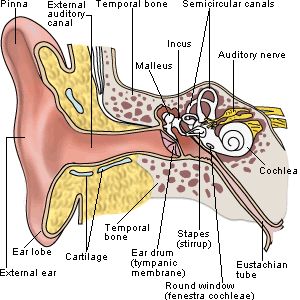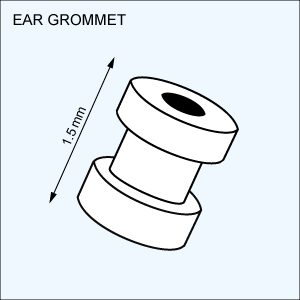Grommets are tiny tubes that can be inserted into the eardrums to treat conditions that affect the middle ear, such as recurrent middle ear infections and glue ear. Glue ear, also known as otitis media with effusion, is a persistent build-up of fluid in the middle ear that can cause hearing problems.
How the middle ear works

The middle ear is an air-filled space that contains 3 tiny bones (ossicles – the malleus, incus and stapes). Vibrations from sound waves are transmitted from the ear drum to the ossicles, which amplify the sound and pass on the vibration to the inner ear.
The Eustachian tube
The middle ear is connected to the back of the nose and throat by the Eustachian tube. The Eustachian tube:
- allows air to enter the middle ear;
- helps maintain an equal air pressure inside and outside the middle ear, allowing the eardrum to vibrate efficiently; and
- drains fluid and mucous from the middle ear to the back of your nose and throat.
The Eustachian tube opens to allow the pressure to equalise in the middle ear space. This causes the click or pop which you may have experienced when travelling by plane or driving up a steep hill. These ‘pops’ are evidence that your Eustachian tube is doing its job.
If the Eustachian tube is not working properly or is blocked by inflammation or mucus, the air in the middle ear is absorbed but cannot be replaced. This causes the air pressure in the middle ear to be less than the air pressure in the ear canal.
The negative pressure (partial vacuum) in the middle ear causes fluid to collect there. Over time this fluid tends to become thicker, leading to the name ‘glue ear’.
Glue ear is more common in children than in adults, partly because children’s Eustachian tubes are narrower and more horizontal, which means that they can block more easily.
Middle ear problems and hearing
When the middle ear is filled with fluid, the ear structures become less mobile and less capable of carrying sound vibrations to the inner ear. The type of hearing loss this causes is referred to as conductive because the sound is prevented from being properly ‘conducted’ through the middle ear to the hearing nerves in the inner ear.
- have trouble hearing;
- be irritable;
- have trouble paying attention; or
- display behavioural problems.
Hearing problems associated with glue ear can lead to problems with speech and language development. Rarely, children with glue ear have problems with balance or a dull ache in the ear.
Grommets
What is a grommet?
A grommet is a tiny plastic or metal tube about 1.5 – 2 mm wide.

A grommet is a tiny tube that is inserted into the eardrum to allow air to enter the middle ear. The grommet does the work that the poorly functioning Eustachian tube should be doing, giving the middle ear a chance to recover.
Grommets cause no discomfort while in place. They usually fall out on their own in 6 to 12 months, leaving the drum intact.
Related Posts
When are grommets used?
Your doctor may suggest inserting grommets if your child has had glue ear for at least 3 months and has associated problems with their hearing. For children with recurrent ear infections, grommets may help prevent recurring infections.
How are grommets inserted?
This involves a simple surgical procedure called myringotomy, where a small cut is made in the eardrum and any fluid is suctioned out. The grommets, also known as ventilation tubes, or tympanostomy tubes, are then inserted into the eardrums to drain fluid and ventilate the middle ear. The procedure usually takes about 15 minutes.
The procedure is done under a general anaesthetic, and is usually done as a day only procedure – your child will not usually need to stay overnight in hospital.
Caring for a child with grommets
Most children recover well from the operation to insert grommets. You should see your doctor if your child experiences pain, or any discharge from the ear that lasts for more than 5 days.
To avoid getting an ear infection, your doctor may suggest that your child avoids getting their ears wet with water that may have germs, such as bath water. Earplugs may be necessary when bathing and showering.
Earplugs should also be used when swimming. Swimming should be avoided altogether for the first week after the grommets are inserted. If your child develops a discharge from the ears, see your doctor.
If your child had hearing problems before having grommets, they should have a hearing test soon after the grommets have been inserted to check that their hearing has improved. Most children have a full recovery in their hearing.
To read more visit:
https://theconversation.com/glue-ear-theres-a-better-alternative-to-grommet-surgery-212660
Related
ncG1vNJzZmilqZm%2Fb6%2FOpmWarV%2BgtqW%2FjK2cnqajYrWmrcutn2ilmZmxrbGMnpirZZmjs6av06Kmp2WRo7Fus9GopKadpKh8